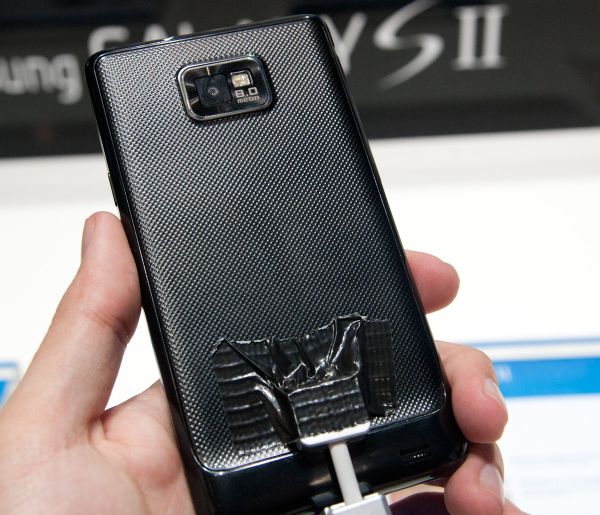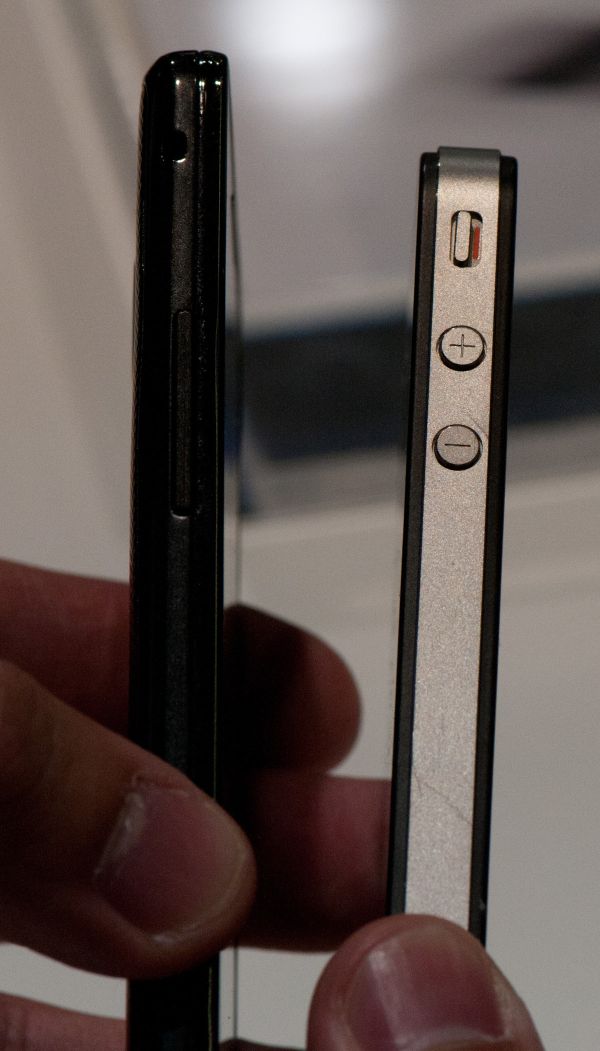Samsung's Galaxy S II Preliminary Performance: Mali-400MP Benchmarked
by Anand Lal Shimpi & Brian Klug on February 14, 2011 12:38 PM EST- Posted in
- Smartphones
- Samsung
- Arm
- Orion
- MWC 2011
- Galaxy S II
- Exynos
- Mali 400
- Mobile
- Trade Shows
Our impressions with the Galaxy S II are very positive, it's much improved over the Galaxy S. Probably the most immediately appreciable change is the completely different screen and in-hand feel. Samsung's Super AMOLED Plus display does away with the PenTile grid that graced the original set of AMOLED displays, and instead uses an RGB line array just like a normal LCD. 
At the same time, Samsung is advertising response rates of below 1 ms, improved gamut, and viewing angles. From what we saw, Super AMOLED Plus was impressive, and having a 4.3" screen doesn't seem unmanageable compared to 4".
The backside of the Galaxy S II is completely changed - thank goodness. Gone is the super-slick and scratch prone glossy plastic. In its stead is a textured surface that won't show aging nearly as much. The entire back doesn't peel up to reveal the battery, just square shaped area. During our testing and just playing with the Galaxy S II, the phone seemed to get inordinately hot, much hotter than I remember any other smartphone getting. It's also impressively thin - just 8.48 mm compared to the already super thin 9.91 of the old Galaxy S, and thinner than the iPhone 4's 9.3 mm.
Almost all of the button placement is the same as the old Galaxy S, what's curiously different is the presence of a center home button and removal of the Android search button. It's amazing how integral the search button really is - in some contexts (namely kwaak3) it's the only way to bring up menus since it used to be a button every Android device was guaranteed to have. Whether this is something that will change in carrier-specific versions is something that remains to be seen.
The Galaxy S II has an HSPA+ baseband with 21.1 Mbps downstream support. It's unclear whether any of the networks here at MWC have HSPA+, so although we ran speedtests, we're not sure if they're representative.












62 Comments
View All Comments
mwarner1 - Wednesday, February 16, 2011 - link
I agree that the US situation is very poor with respect to the Carrier customised Galaxy S variations.Personally I believe it to be the carriers fault and not Samsung's- we know that 2.2.1 is available in the rest of the world's Galaxy S devices, so it is not as if they can't get the base firmware from Samsung. I think the main issue is that the US variants are carrier modified, and so they will have to port those modifications (different button layout, camera differences, memory differences, baseband differences etc) to 2.2. This will require significant network revalidation, be very expensive and only really matter to a fairly small percentage of their users.
To your other points:
Kies - I am not sure why you would want to use this? I don't think I have ever used Kies, and can;t see why I would need to.
Hack of 2.2 and 2.3 - This is true - it does use a custom built 2.2 kernel and incorporate a number of 2.3 packages. This, in my opinion, is a good thing as long as stability is kept, as you get new features (such as the excellent 2.3 keyboard) early. Personally I have not found any stability issues whatsoever.
Battery issues - I think you will find that the vast majority of users (and all users who are technically competent) find that battery life is better then the generic Samsung firmwares.
Reliability - I would be surprised if anyone has managed to brick a Galaxy S unless they pulled the power or a cable during a firmware update. People with little experience who have messed something up may think they have, but the situation is almost always recoverable.
Trust - I suppose you can trust who you like, but Darky (like all modders) is just another user like you and I who has decided to improve on Samsung's firmware. The custom firmwares I have created were purely done for my own interest and to improve upon the base phone that I had been supplied. There are always other modders who will look at the content of these firmwares to improve on them or see how they do something, and if something looks suspicious it will soon be picked up by the modding community.
If you wish to hear Darky talk about his firmware, then you can always listen to TechTalkUK's podcast:
http://www.techtalkuk.com/2011/01/16/techtalkuk-po...
Mike
synaesthetic - Wednesday, February 16, 2011 - link
I won't buy an Android phone that I can't root and flash a custom ROM to.That's the whole POINT of Android!
If I wanted something that "just worked" out of the box, I'd buy a goddamned iPhone.
jmcb - Thursday, February 17, 2011 - link
'I wont buy an Android phone that I cant root and flash a custom ROM to.Thats the whole POINT of ANDROID!"
No thats not the whole point of Android... the problem is some ppl think it is..
Rooting and custom ROMs are an added bonus, luxury.
Belard - Wednesday, February 16, 2011 - link
Looks like the Captive is not on the compatibility list for Darky... it requires Froyo to be be installed.... or at least about another 5 tools to install.This is the kind of crap that should get Samsung sued. 2.2 was promised. It fixes a lot of problems with their own products.
mwarner1 - Wednesday, February 16, 2011 - link
A few points:1. The Captivate is certainly supported - see the ODIN edition.
2. You don't need to have FroYo installed when using the ODIN edition.
For those of you who are unfamiliar with ODIN, it is the Samsung built application that is used to flash a specific firmware onto your device. In essence you download a firmware, run ODIN, select it & hit Flash (slightly more complex than this, but it is the essence)
The other way to flash firmwares on Android devices is to boot into recovery mode (e.g. 2e on the Galaxy S or CWM if you have it installed) & select a zip file to flash. This method is, in my opinion, more complex but more common as it is a generic android way of changing your firmware.
Once again, I am surprised that people on Anandtech are worried about flashing the firmware on their phones - I think I have reflashed every device I have owned since my Sony Ericsson T610 in 2003. I agree it is a hassle to reinstall all you apps and backup all your data, but if I were stuck on a US 2.1 device I know what I would do ... I purposefully changed to a Custom Firmware from a generic Samsung 2.2.1 firmware!
Belard - Wednesday, February 16, 2011 - link
Thanks...I've been checking out the screenshots. I want many of those features.
I want to customize the phone into something better. I want more useful info on the desktop than what comes default on my at&t Samsung (could be worse... verizon) - My dumb Sony had more useful info and didn't require unlocking it to view alarm & time info... stuff like that.
My biggest concern is fracking up the phone.
ssj4Gogeta - Tuesday, February 15, 2011 - link
Kies 2.0 has fixed most of the issues.Belard - Wednesday, February 16, 2011 - link
I've downloaded the latest Kies 1.x from Samsung about 3-4 weeks ago, so I'll give it a worthy try.Belard - Wednesday, February 16, 2011 - link
Nope... the latest Kies available from Samsung's website is from Sept 2010 and its 1.x.kablunkie - Tuesday, February 15, 2011 - link
Forgive me as this is mostly off topic, but it has to do with your benchmark tests.I own a dell streak, and after months of waiting for 2.2 OTA, I flashed a custom rom. It was like a new phone, more specifically performance drastically improved. According to the quadrant graph, even with 'stuff' running, it exceeds the nexus one 2.2 (top of quadrant tests). No overclocking/perfmod.
I am not sure what you policy is regarding custom ROMs/OS given it is not what it came with, not officially supported, voided warranty.
I do want to say thanks for including the Dell Streak on your benchmarks and enjoy the site.